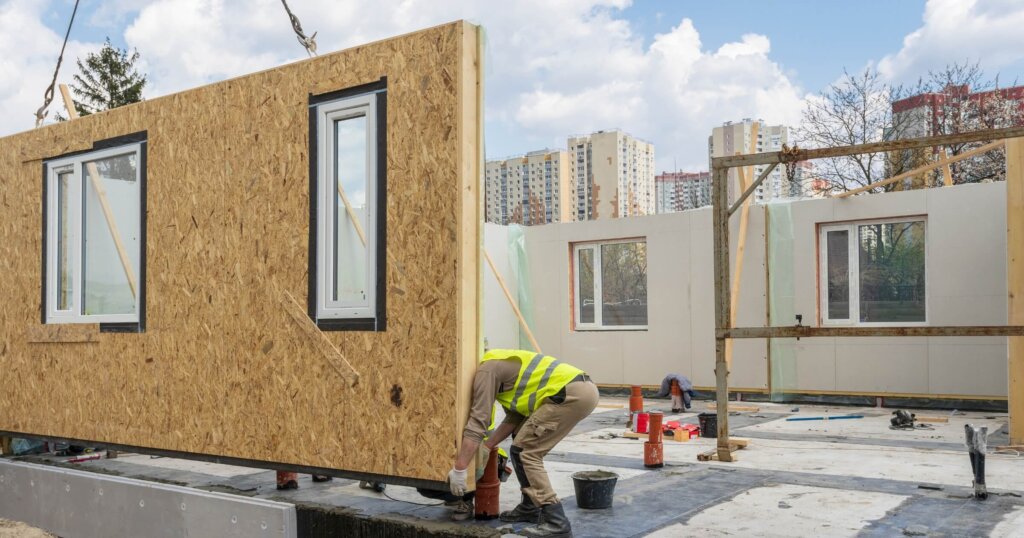When planning a build using off-site construction, it’s easy to mix up modular and prefab methods. They might sound similar, but they involve different processes, timelines, and design options. Knowing the differences can help you pick the right fit for your project’s needs and goals. In this article, we compare modular vs. prefab construction methods in terms of process, customization, cost, and logistics when building a new home.
Quick look:
- While modular is a type of prefab, it involves fully finished modules, unlike panelized or SIP systems that require more on-site work.
- Modular builds are faster and more standardized, ideal for repetitive layouts. Prefab systems offer more design customization.
- Modular units need heavy transport and equipment, while prefab components are easier to ship and assemble in tight spaces.
- Modular units are built to endure transport and often exceed code requirements, while prefab components depend more on proper on-site assembly.
What is prefab construction?

Photo courtesy of Shutterstock.com
Prefab, short for prefabricated, is a general term that covers any building method where parts of the structure are made in a factory and then transported to the construction site. Instead of building everything from scratch on-site, crews assemble pre-made components, which can save time and reduce waste.
There are several types of prefab systems. Panelized construction uses large wall or roof panels that are built off-site and then lifted into place. Structural Insulated Panels (SIPs) combine framing, insulation, and sheathing into a single piece. Some builders also use precut framing kits that include everything needed to assemble a home quickly, like a giant puzzle.
What is modular construction?

Photo courtesy of Shutterstock.com
Modular construction is a specific type of prefab that uses large, box-like sections called modules. Each module is built in a factory and comes with plumbing, electrical, insulation, and interior finishes already in place. Once complete, these modules are transported to the jobsite and assembled into a finished structure.
Because so much of the work is done off-site, modular builds often move faster and with fewer weather delays. On-site crews focus mostly on connecting the modules and making sure everything is sealed, secure, and up to code.
5 main differences of modular vs. prefab construction
Degree of completion in the factory
One of the biggest differences between modular and other prefab methods is how much of the work is done in the factory. Modular buildings are typically 90 to 95 percent complete by the time they leave the manufacturing facility. That includes plumbing, wiring, insulation, windows, and even interior finishes like paint and flooring.
In contrast, other prefab systems, like panelized walls or SIPs, focus on specific parts of the structure. These components still require a lot of on-site labor for framing, mechanical systems, and finishing work. While they can speed up certain parts of the build, they don’t arrive nearly as finished as a full module.
Customization and flexibility
Modular construction tends to follow a more standardized approach. This is especially true for projects like apartments, hotels, or offices, where repeating the same layout across multiple units saves time and money. Because the modules need to be transported and stacked, design choices may be more limited compared to traditional builds.
Prefab methods like panelized systems or precut kits offer more room for customization. These systems can be adapted to suit unique floor plans, rooflines, and architectural features. If your project involves creative layouts or specific design elements, prefab might offer a bit more freedom to bring your vision to life.
Speed and on-site installation time
Modular construction is known for its speed. Since the modules are built in a factory while the foundation is being prepared on-site, both stages can happen at the same time. This parallel process can shave weeks or even months off a project timeline, which is a big plus for developers working under tight deadlines.
Prefab methods like panelized systems usually don’t allow for quite the same overlap. While they’re still faster than traditional stick-built construction, they often require more on-site labor and coordination between trades. That can lead to longer installation times and more room for delays if crews or materials don’t line up perfectly.
Structural durability and code compliance
Modular buildings have to survive transport and placement. Because of this, they’re often built to meet or exceed local and national building codes. In many cases, they’re reinforced to handle the stress of lifting, shipping, and stacking on-site, which can make them even more durable than conventional builds.
Other prefab components, like wall panels or SIPs, are built to fit within a larger construction plan and need to integrate with traditional on-site methods. These systems still have to meet code, but they rely more on the builder to make sure everything is properly installed and inspected during assembly.
Transportation and logistics
Moving modular buildings from the factory to the site is a job in itself. Since the modules are large and mostly finished, they require flatbed trucks, special routing permits, and sometimes even police escorts. Site access also needs to be planned carefully, with enough room for cranes and equipment to lift and place each module.
Prefab systems like panelized walls or precut framing kits are much easier to transport. They can be packed flat, loaded onto standard trucks, and handled with smaller equipment. This makes them a more flexible option for remote or tight job sites where maneuvering large modules would be a challenge.
Modular vs. prefab construction: Which method should you choose?
Both modular and prefab construction offer faster, more efficient ways to build, but the right choice depends on your specific project needs. Modular buildings arrive mostly finished, which means faster timelines and fewer weather delays. They’re a great fit for projects with repetitive layouts, like apartment complexes or hotels, and for jobs that need to move quickly.
Prefab systems like panelized walls or precut kits offer more design flexibility and are easier to transport and assemble on smaller or harder-to-reach sites. They’re often a better choice for custom homes or builds with unique architectural details.
Want more insights like this? Subscribe to our newsletter for construction trends, tools, and industry updates delivered straight to your inbox.


